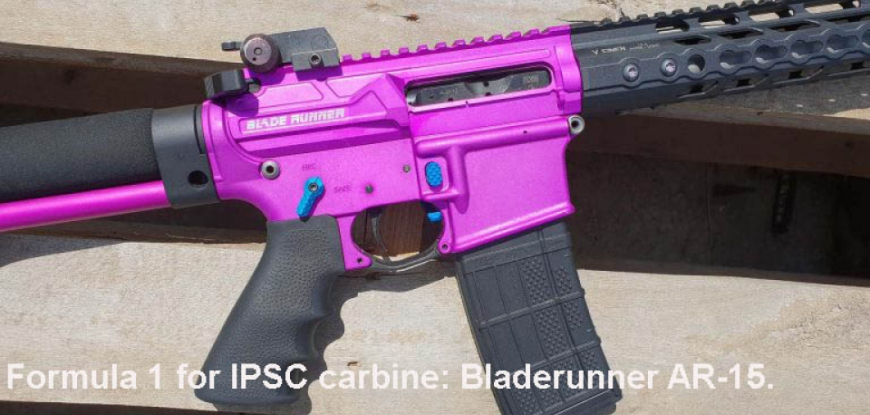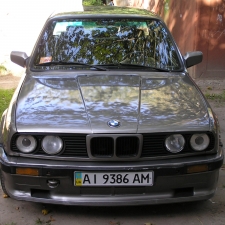FORMULA 1 FOR IPSC CARBINE: BLADERUNNER AR-15
It’s impossible to buy a perfect rifle, you can only build it by yourself.
Introduction.
This article devoted to my emulative rifle, based on AR-15, I participate with it in dynamic shooting sports types. I would like to share with my perfect rifle build experience for sport, however, I wish to point out that this way is one of the several possible. Everything depends on your needs, wishes and, first of all, each shooter personal belief.
The rifle which will be discussed - it’s emulative rifle for a practical shooting, with 20” fluted match barrel. It’s based on DPMS TPR 20″, .223 caliber. At the moment, I left only the barrel and lower receiver.
There are two main paths of the rifle preparation for dynamic shooting sports types - adjustment of automatic smooth work for minimizing the deviation after a shot plus the weight decreasing and ergonomic work.
The task for regulation the automation of this carbine is fully completed and at this moment this carbine recoil power, at shooting, is approximate as .22LR at the most high-speed cartridges and that's not an exaggeration.
The work on an automation softness and minimization of the deviation after a shot.
Used a lightweight bolt carrier group by Faxon Firearms and low mass operating system buffer. The total mass of moving parts is about 8 ounces. The standard carbine has 15-18 ounces.
The automation is configured through an adjustable gas block by Superlative - at the moment, in my opinion, this is the best adjustable gas block on the market.
As to muzzle brake, I use a titanium option from SJC Titan. I believe, this is one of the top two muzzle brake compensators for sport, it corresponds to the requirements of Standard class semi-automatic rifles, which I participate in. I chose the titanium one due to the struggle for weight reduction. In my opinion, another 80 grams on the 20-inch barrel cut are worth removing.
- Reference -
The practical rifle shooting has four main or “standard” class:
- semi-automatic open - semi-automatic rifles with optic and optoelectronic sights (collimator sights, constant or variable multiplicity optic sights);
- semi-automatic standard with mechanical sights.
- manual open - hand overcharge rifles (slideways bolts, which demands hand overcharge after each shot) with optic and optoelectronic sights;
- manual standard - hand overcharge rifles with mechanical sights;
In 2018 were added 3 more class, which could be called experimental:
- Kalashnikov open - the name speaks for itself.
- Kalashnikov standard;
- pistol caliber - gaining the world’s popularity carbines with pistol calibers cartridges.
To each class gun, certain technical requirements are applied, which are pointed out in each sports type.
Acquire double-alpha by a split in a IPSC standard target, only possible at 28-35m. At competitions, split shooting on this kind of distance is rather an exception, since more likely to "lose" alpha on a gripe error, however, the missing uplift and the total lack of recoil allow to shoot faster and not only with splits but controlled pairs at long distances. Such builds help to gain stability in shooting from uncomfortable positions or a bad grip shooting. Also, a set of measures to facilitate automation works simultaneously to reduce the overall weight of a gun, which positively affects the accuracy of firing from the hands at long distances.
- Reference -
The split is a superfast double shot in the target within the range of 0.1 sec. between shots.
I make use of Hiperfire 24 3Gun trigger system. I came to it as a result of an active and thoughtful testing of a dozen different triggers. It’s as fast (in my case at a peak even faster) as a “golden standard” in the form of Geissele Super 3 Gun, though precise shots, especially from hands on a distance from 100 and more, are getting easier for me with this trigger.
Struggling the overweight.
During the struggle of weight loss, I installed a V Seven Hyperlight Magnesium 13.5″ forehand. This forehand even lighter than the lightest aluminum ones (with this length it’s minus 100-150 grams), which very important, when it comes to uploading the gun front part, since “nodding off” due to the barrel mass - it’s a common thing for the AR-15.
As well, I use a lightweight stock by ACE Skeleton. It’s light and crash-proof stock with a fixed length. It suits me well without a rubber butt. The most important that it uses the rifle action system, which works softer than a carbine.
In addition, to facilitate the rifle, the receiver pins were replaced from steel to lightweight titanium. The magazine reset button has been replaced with a steel one made of aluminum alloy. A double-sided safety selector is also partly made of an aluminum alloy. The pistol grip steel screw was replaced to titanium.
Also, I removed the ejection port/dust cover because the whole unit weighs 20 grams. For me, it’is still a controversial decision and I haven’t decided whether to leave it as it is. Probably, I will install a lightweight ejection port/dust cover V Seven, with the weight of the entire unit of 9 grams.
The upper was replaced, as well, from a standard Mil-Spec to Odin Works. I want to make a notice, that this upper is not lightweight, it weighs exactly the same as Mil-Spec upper with a steel forward assist. Odin Works doesn’t have a forward assist. The upper replacement was based solely on the appearance, since the desire to achieve the original design was presented from the very beginning.
The final rifle weight without any sights and magazine is 3040 grams, that for the full functioning rifle with 20” fluted match barrel is a pretty much good result. The standard weight of AR-15 with this barrel is 4-4.5kg.
Ergonomic modifications.
I modified ergonomics and carbine controls in my image, guided by my skills and preferences in a shooting. I set a two-sided Raptor charging handle because it has big “pedals” on charging handle latches and it gives a chance for equal manipulation during the shooting from any shoulder. Likewise, I installed an enlarged BAD Lever, it’s main purpose - the start acceleration from the 3-d position.
- Reference -
3-d position or weapon position #3 - the starting weapon position before starting the exercise, when a weapon is completely discharged and the magazine is disconnected.
The double-sided safety handle is very handy for me, it allows to divide the work with the safety in two fingers, the thumb only turns off and the index turns on, which quite useful for me in controlling the rifle. Also, this method works the same for shooting from either strong or weak shoulder.
The rubberized pistol grip by Hogue the most suitable for me, that’s why it was mounted on the carbine.
In addition, I want to focus on the perfect forend contour for me and plasma covering, which makes holding the carbine as suitable as possible and allows using different grip ways.
Appearance.
Since the camouflage characteristics of weapons are not important in sport, I waited long to have a bright competitive carbine. There were several ways to work with the look - painting with wear-resistant Cerakote, standard painting, anodizing. The usual painting didn’t suit me, whereas with the variety of options, it adds a small layer to the details and the grip for them was sort of “blanched”. Painting in Cerakote is a good option, but in my opinion, it’s more suitable for utilitarian purposes or painting a gun in camouflage. The anodizing is remained, however, to find a production that can do such things at the highest level and agrees to work with weapons, turned out to be not a very simple task, anyway, I managed it.
This type of covering has certain technical limitations and nuances, but the look of color anodizing is amazing, as for me.
As a color solution, I chose the movie “Blade Runner 2049” aesthetics, which I was very impressed with. More precisely, the aesthetics and colors of one of the essential movie scenes.
As well with the laser engraving help the inscription “Blade Runner” applied to the upper, now this is the name of its own carbine.
I believe that I have every right to call my build the name whatever I want.
The improvements were so extensive that now it is DPMS only on the paper, although everything remains completely within the law - the changes have not touched the main parts of the rifle.
The appearance is not finished, because there are a number of technical difficulties with the forend magnesium alloy covering. Probably, the barrel will also change its color. However, this all requires disassembly of the rifle, and in the shooting season, I do not want to do this. These are plans for the winter.


blog comments